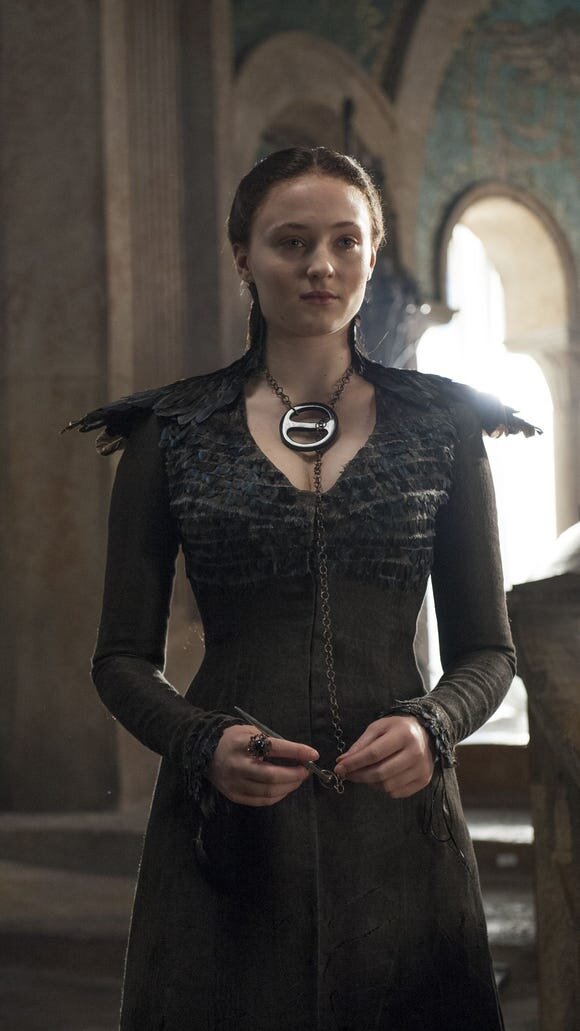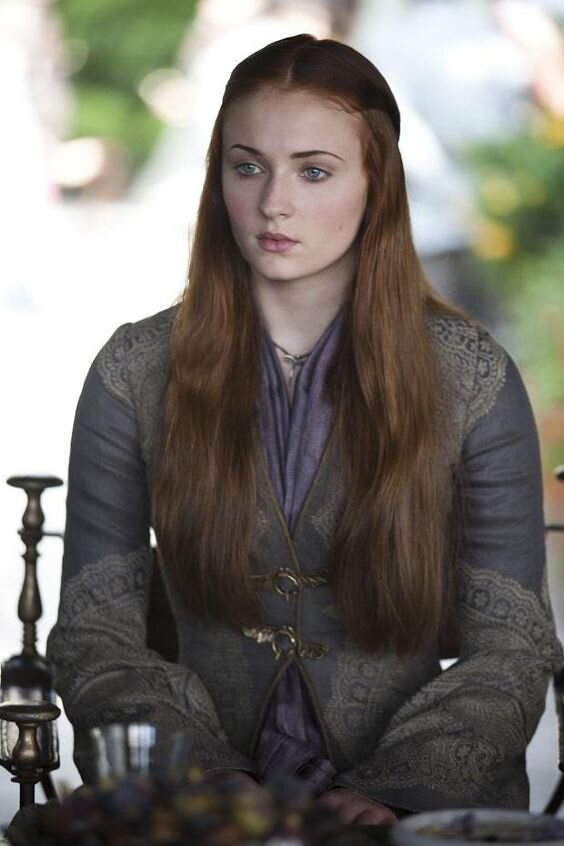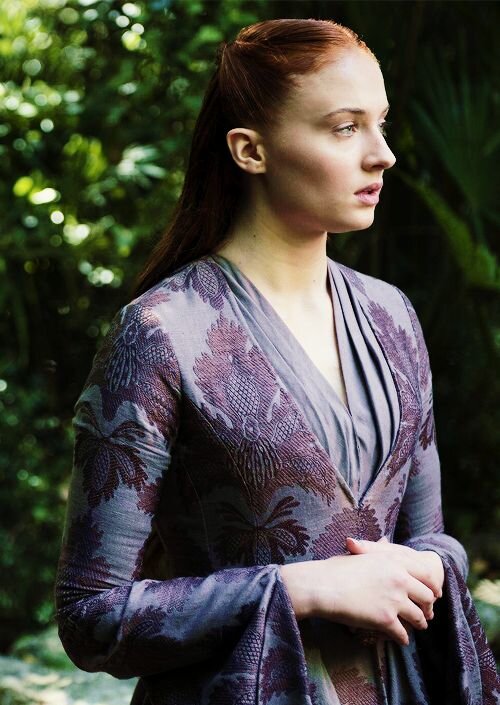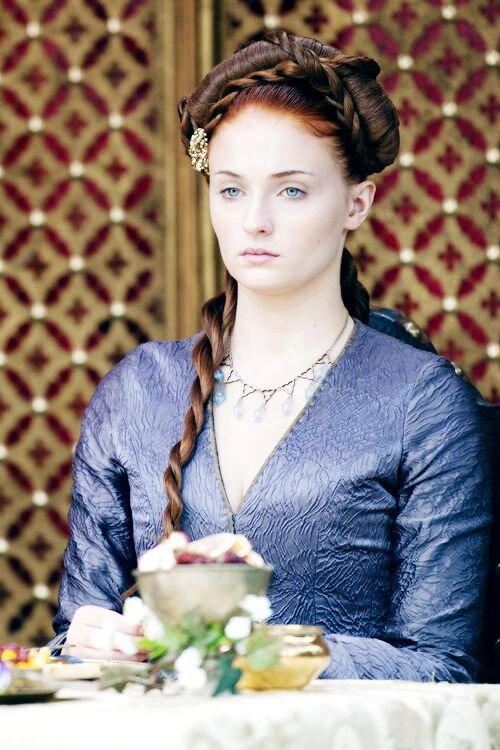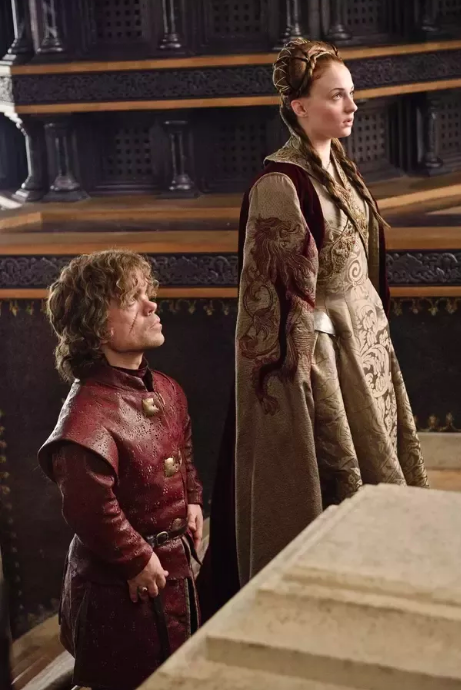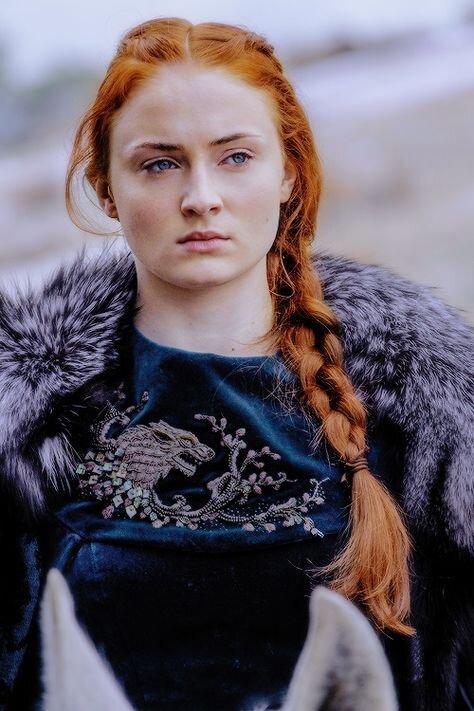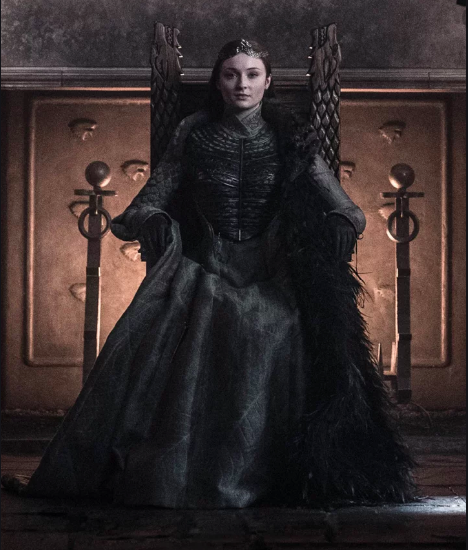Dressing Game of Thrones: The Telling Story in Sansa Stark's Fashion
I will admit to possessing a peculiar weakness for costume dramas. Couple that with another weakness of mine — the fantasy genre — and no one should be surprised by the profound effect HBO’s Game of Thrones had on me. The past several years saw me looking forward to spring in equal parts because I’d escape the harshness of winter and a new season would air. This is no small matter when one considers Canadian winters. The fashions of the ladies in the King’s Landings court in Westeros beguiled me from the start, but the one that grabbed me the most was Sansa Stark’s. This wasn’t necessarily because the character’s fashions were remarkable, but because they were so well utilized in reflecting as well as developing Sansa’s very subtle nature. Her costuming indicated nuance in a character that has often been read as a damsel-in-distress exuding fragility and propriety. The show started off with a pre-teen Sansa who subscribed to every patriarchal norm. She dreamt of nothing more than to be married to someone gallant and well-bred, and devoted herself to the homemaking arts in hopes of being a good wife and mother. As the series progressed, she grew out of that mold slowly but surely, and eventually rallied her region, The North, to its independence. This culminated in her becoming their queen — most notably, without a king.
Sansa in the capital, King’s Landing, in the Southern region in season one.
The Use of Color and Cut of Dress
Game of Thrones can best be characterized as a medieval fantasy, which meant that dresses were always long and flowing. While they ranged in sleeve length, Sansa always wore long sleeves in even the balmiest summer weather in the southern region of Westeros, indicating her modesty. Color in particular took on meaning in displaying the character’s evolving personality throughout the show, from her start as an innocent and sheltered girl to a more politically strategic and hard-nosed woman. Raised to be a proper ‘good girl’ with hopes of being nothing more than someone’s wife, season one saw Sansa betrothed to the show’s first reigning sociopath, Prince Joffrey Lannister. Much of that season visualized her innocence by dressing her in pastel colors with subtle accents such as flowers. During her time at home in Winterfell in season one, we saw her outfitted in a pastel blue. After she moved to King’s Landing, we saw her in a variety of pastel shades such as green and pink.
The color green stood out for me in season one when she wore a pale, pastel green in the scene where her father was executed. This event was the largest turning point for every character in Game of Thrones, particularly Sansa. During her escape from her second husband, the sadistic Ramsay Bolton (the second reigning sociopath of the show), she wore what appeared to be an olive-green printed dress. However, the ambiguity of the color of the printed dress confused me, as well as others I spoke to. At odd points, it appeared grey and in other scenes it seemed to be olive-green. However, grey wasn’t a stretch to consider since Sansa wore the muted, formal color on more than one occasion, which suited her personality well. She was later reunited with her brother, Jon Snow, in the same printed dress, albeit in tatters. The choice of green along with the style of Westerosi dresses drew parallels to another costume drama and its resident good girl: none other than Mina from Bram Stoker’s Dracula. I often wondered if Game of Thrones costume designer Michele Clapton was inspired by Eiko Ishioka, who won an Oscar for her costumes in Dracula and served as inspiration for many subsequent fantasy films, such as the Lord of the Rings series. Many of the dresses in Game of Thrones were long and flowing with the dramatic bell sleeves we saw decades earlier in Ishioka’s Dracula. Apart from the iconic scene in which Mina wore a blood-red dress in a meeting with Dracula, she was often outfitted in different shades of green. Also seen as a proper good girl at the start of the movie, I wondered if Clapton meant to create the same effect with Sansa by outfitting her in green during her father’s execution. Sansa was shown in the dress again later in the series.
The ‘Dark Sansa’ look in season four.
Despite the dramatic effect of the color black and its hint of finality, the color suggested a type of flexibility for Sansa. During her time with the masterful schemer Petyr Baelish she wore long, high-necked outfits in black that had the effect of producing a mournful look. This was quite possibly a foreshadowing of her most difficult time still to come. Soon after, Baelish sold her off to the Bolton family, where she was repeatedly raped and beaten by her new husband, Ramsay Bolton. After the death of her Aunt Lysa, Sansa wore a notable black outfit with a striking black-feathered collar in a final scene with Baelish and her cousin. This was her first time outfitted fully in black, which gave way to the fan-given nickname, “Dark Sansa.” The feathers were of strong significance since Sansa was often referred to as “little bird” throughout the series and “little dove” by one of the series’ chief villains, Cersei Lannister. In later seasons, after her reluctant brother Jon Snow retook their family’s home at Winterfell from the Boltons with strategic help from Sansa, she wore black again.
This time, the effect was much more powerful and dramatic. Most scenes saw her in a dress with black fur and black leather accents that conjured a gothic vibe. But several scenes saw her outfitted in a tight black leather bodice with the newly assertive Sansa creating an effect that can only be described as a medieval dominatrix. Of course, this was confusing in and of itself, considering that Sansa was notably not a sexual creature, which stood out in a show that pushed the limits of explicit sexuality. However, this dominatrix look seemed more to be indicating the duality of Sansa’s nature — both what appeared on the surface, and what was now lurking underneath. Sansa’s subtle, frightened nature made her an obvious submissive for much of the series. But, as the Lady of Winterfell, she was now in charge, which made her politically dominant. It must be said that her combined traumatic experiences, along with being back in her ancestral home and reunited with her family, brought out an assertiveness that she struggled to summon for most of the show when she was a prisoner to both the Lannister and Bolton families. The black leather suggested this new development in the character. It also foreshadowed a new powerful side still to come — Sansa Stark, Queen of the North. Black, therefore, was the color of foreshadowing for this evolving character — in this case, reborn from a naïve girl with silly dreams to an unmarried Queen of a strong and independent kingdom. Coupled with Sansa’s fiery red hair, she seemed to be a phoenix being reborn from its ashes — an apt analogy, considering the entire series’ connection to fire and mythical beasts such as dragons.
Unfortunately, the flexibility of black in Sansa’s costumes was not extended to the color white. This was the color Sansa wore to her wedding to the depraved sociopath Ramsay Bolton in the middle of a snowy night in Winterfell. It was also the night that saw the most traumatic event of her life — the night she was first raped by Ramsay. There aren’t many scenes that recall Sansa decked out in the color white, which meant that the Thrones creators meant to use her snow-white dress to accentuate the character’s innocence before it was thoroughly stolen from her for good. White generally cannot be as flexible as black, owing to its traditional role in portraying innocence. Furthermore, Sansa was again outfitted in a capelet, reminiscent of her feathered collar in her ‘Dark Sansa’ outfit. I couldn’t but help think of the nickname she was given by Cersei Lannister (‘little dove’) in this scene. Doves are synonymous with purity and virtue, which is quite possibly what the creators meant to connote with this small accent.
Finally, the most obvious evidence of just how much color and fashion factored into Sansa’s character development was the event that was dubbed ‘The Purple Wedding’ in season four. This event marked the assassination of King Joffrey, a long-time tormentor and relentless bully of Sansa. It took place during an especially trying time for Sansa, who fell into a depression after the murders of her eldest brother and mother were masterminded by her prisoners, the Lannister family. Decked in a splendid, flowing dress in vibrant purple, it was the then-fragile Sansa who played an unwitting part in Joffrey’s assassination. Her necklace, which was gifted to her by Joffrey’s Fool, was made of purple stones that looked like amethysts. They were in fact the poison known as ‘the strangler,’ and one of them was plucked from Sansa’s necklace and discreetly dropped into Joffrey’s drink by the Lady Olenna Tyrell, choking and killing him. Thus, Sansa’s outfit was at the center of the entire premise of the episode. Most tellingly, purple seemed to be a foreshadowing color as well, when one considers that Sansa wore a purple and grey dress during her first meeting with Lady Tyrell several seasons back. And it continued to be a color she noticeably wore on many occasions, for instance, when she was accompanied by Petyr Baelish to her Aunt Lysa’s kingdom. She also wore a purple dress accented with flowers in season one when she was given a rose by Loras Tyrell — a man to whom she was briefly betrothed.
Accessories and Imagery
The example of the ‘Purple Wedding’ necklace was the most dramatic use of accessories in the series’ storylines. While subtler, Sansa’s other necklaces also suggested her phases in personality. Many of the earlier seasons saw her in a simple silver necklace with a dragonfly pendant that signalled her fragile nature. However, the necklace she wore in later seasons during her time as the Lady of Winterfell was a dramatic silver chain, woven through a large circular loop. Often shown paired with her all-black outfit made with fur and leather accents, the chain in this necklace was reminiscent of the dominatrix-esque leather bodice, an undoubtedly intentional allusion. The necklace was also reminiscent of the one she wore with the ‘Dark Sansa’ outfit, which was a chain looped through another circular pendant. The only major difference was that the chain in the ‘Dark Sansa’ outfit was a lot longer.
Sansa’s chain necklace in season eight.
Accessories weren’t the only items that symbolized the character’s temperament. During her wedding to the benevolent Tyrion Lannister, her outfit included a stitching of the Lannister family sigil — a lion — on the sleeve of her wedding cloak. The effect was of a vicious lion clawing and licking at her arm. Considering that the Lannisters were her prisoners, such an image takes on a stronger and more ominous meaning. She was also dressed in the Lannister colors — gold and red — for the wedding, indicating just how much she was under their control. Leading up to the battle that would see her family retake Winterfell, Sansa, her brother, and their men met with Ramsay Bolton and his men.
In this memorable scene, Sansa is seen in an exquisite blue velvet dress with an embroidered image of her family’s sigil — a direwolf –with flowers growing out of it. The implication was that of a woman with an underlying ferociousness masked with a gentle countenance. Such a choice in outfit should surprise no one when one considers that Sansa named her direwolf pet in season one “Lady.” The scene in question saw Sansa outwardly threaten her former rapist, Ramsay, telling him calmly, “You’re going to die tomorrow, Lord Bolton. Sleep well.” This episode saw Sansa’s contribution to the battle through an alliance with a new army that came to the rescue of Jon and his smaller army. After the battle was tidily won and Ramsay was taken prisoner, Sansa had him fed to his own dogs as she watched the violent scene for a few minutes. Thus, the underlying ferociousness implied by her earlier costume came to the surface in this one scene.
This episode stood out in Sansa’s character development because her alliance with the army indicated a newfound boldness in the character. This was because she hid this new alliance from her brother for fear that he would not agree to it because the army was led by the treacherous Petyr Baelish. Sansa was later cultivated into a clever politician as the series continued. Furthermore, the most shocking aspect of the episode was the violence she embraced when she chose to have Ramsay fed to his own dogs. It was clear that she was no longer the fragile girl she had been at the start of the series. This was in no small part due to the safety she felt from being reunited with her brother. This safety was only compounded once he seized their ancestral home from the hands of her rapist and Sansa could return to the sense of safety she had felt there as a child.
The outfit that made the final mark in revealing Sansa’s character arc was none other than the last one we see during the series finale. After announcing to her younger brother, Bran, that the North would remain an independent Kingdom, Sansa becomes the Queen of the North. Her outfit at her coronation indicated the sum of her experiences along with her new status. Sansa wore a long and flowing gown made of pale grey (the color of her family sigil) and a tight-fitting, intricate bodice that served as a reminder of her earlier leather one. The new bodice, however, was made of metal and shaped as tree branches. In an Instagram post, the show’s costume designer, Michele Clapton, stated that the tree branches were deliberate, meant to feature the “growing branches of the weirwood tree” — a fantastical tree of special significance to the series. Sansa’s collar was trimmed with fur, which served as a practical reminder that she was now permanently resident in the cold North. The inside of her flared sleeves was adorned with crimson maple leaves, which seemed to imply the blood of her fallen family members and the trauma she faced during her time as prisoner to first the Lannisters and later the Boltons. She was crowned with a small tiara with two direwolves at its centre. This wasn’t the only place her family’s sigil was featured in her outfit. The direwolf was also embroidered at the end of her fur collar. Having survived the show’s two worst sociopaths and some of its most brutal villains — a feat no other female character endured, let alone survived — the outfit and crowning moment led to another character revelation. Having started off as a woman who dreamed of a happy ending with a prince, she seemed proud of this new version of a happy ending with her as a lone queen. Thus, the outfit served as a reminder of her past with her dreams now reconstructed to fit the wiser and mature woman she had evolved into.
“The significance of Sansa’s outfits was their obvious reflections of her character developments, as seen through colors, accents, and accessories. Her earlier outfits in pastel colors indicated her naïve and girly temperament as a young pre-teen. ”
One can only guess what the series would have intended for her in this new phase of life as queen of an independent kingdom. One can only guess what royal outfits would have been intended for a character once fragile and naïve who came into her own as a resilient Queen. It is said that Game of Thrones was based off the English War of Roses, with the Starks being based on the real-life York family and the Lannisters being based on the real-life Lancasters. The historical war ended with a York victory, only to be later attacked and defeated by a Tudor who claimed direct descent to the Lancasters. History states that the Tudor notably married a York princess to legitimize his royal standing. After the series finale, I found myself wondering if that would mean that the Game of Thrones writer and creator, George R. R. Martin, intended that for Sansa in a much later book down the line. As the Queen of the North, Sansa would be eligible to many suitors. Having been previously betrothed and married off to monsters in human form, would she be vulnerable to such a storyline again? If such is the case, technically HBO could start the cycle afresh, filming a new Game of Thrones offshoot and thus making her costumes central to her character arc once more.
The significance of Sansa’s outfits was their obvious reflections of her character developments, as seen through colors, accents, and accessories. Her earlier outfits in pastel colors indicated her naïve and girly temperament as a young pre-teen. Black later became a flexible color that illustrated dramatic turning points in her storyline while revealing stronger character developments. White remained a traditional color that reflected innocence, as seen in her wedding dress to Ramsay Bolton. Her accessories also indicated character changes and reflections in her storyline. The feathers in her outfits were certainly an allusion to the ‘little dove’ and ‘little bird’ nicknames she was previously given. Her necklaces either indicated her fragile nature – as seen in her dragonfly necklace – or boldly moved the plot forward during crucial events such as ‘The Purple Wedding.’ They later accentuated her medieval dominatrix look when paired with her black leather outfits and bodices in Winterfell. Sigils that were woven into her outfits, such as the lions in her wedding dress to Tyrion Lannister and the direwolf in her blue velvet dress before the ‘Battle of Bastards,’ also indicated her change in personality. The latter dress was particularly appreciated by fans because the direwolf was her family sigil and alluded to her pet direwolf in Season One. Finally, the outfit that was the crowning moment that indicated all her character development was none other than her coronation dress as Queen of the North with a rich display of symbolism that commemorated her fallen family and ancestry as well as her allegiance to the North. It was also a moment that closed off on a high note – admittedly the most powerful one for any woman in Game of Thrones. While there were several other queens throughout the course of the series, Sansa’s came at the end of a war, and in the final episode when enemies were killed off and storylines were resolved. Furthermore, she was now the Queen of an independent Kingdom in a medieval story. This outfit was vividly different from the pastels she had worn in the first season when she witnessed her father’s execution. Coupled with the more traditional colors, the outfit’s accessories were symbolic of an older and much more seasoned woman of her time. The show’s costume designer was intent on symbolizing Sansa’s changes with this outfit. Therefore, the creators also wanted to indicate this ‘new’ Sansa, and chose to do so by featuring her and her family’s diverging paths in the show’s final moments, thus creating an effect as dramatic as many of her costumes.


